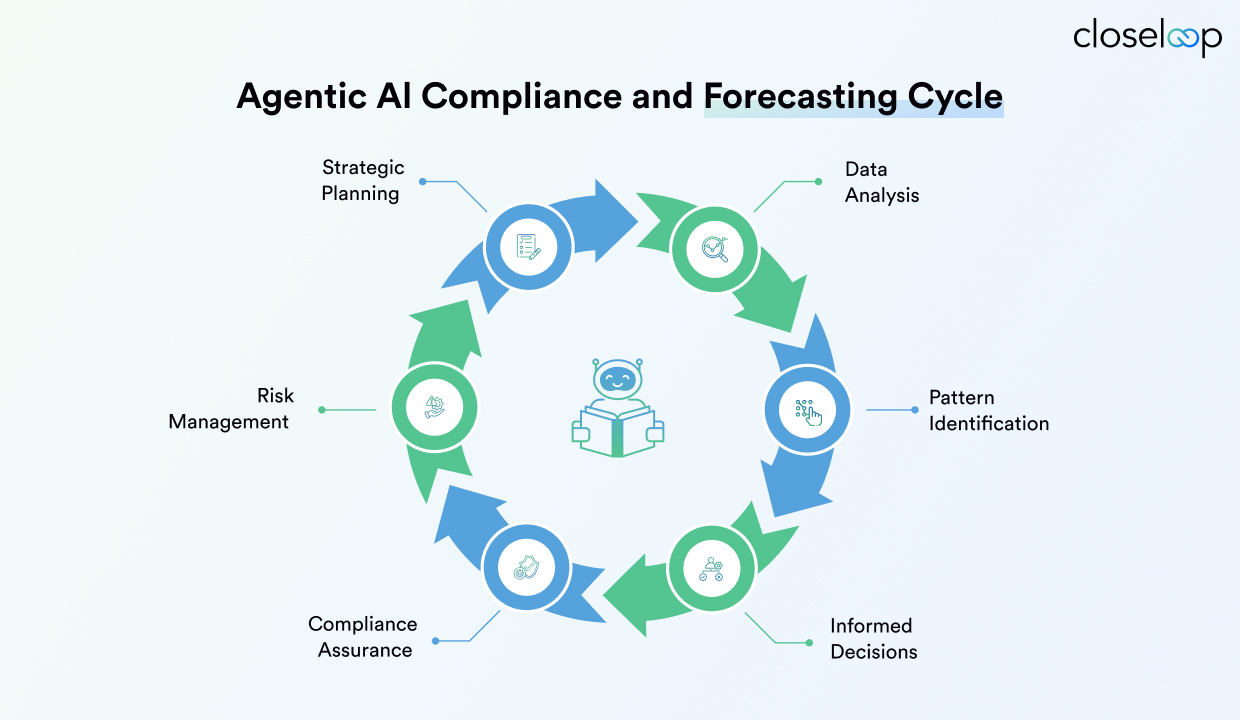Organizations across industries are facing unprecedented challenges in managing complex compliance requirements and delivering accurate forecasting insights. Traditional approaches relying on manual processes, rules-based automation, and static analytical models are proving inadequate for today's dynamic regulatory environment and rapidly changing market conditions, illustrating how AI helps in compliance while demanding more adaptive models for prediction. The emergence of agentic AI represents a transformative solution that can autonomously navigate regulatory complexities while delivering sophisticated predictive capabilities, uniting agentic AI in compliance with agentic AI for forecasting.
A financial institution implementing agentic systems for regulatory intelligence reported reducing their regulatory change assessment time by 65% while improving accuracy, demonstrating the tangible impact of autonomous AI deployment and the benefits of AI in compliance. Meanwhile, the AI for sales and marketing market is forecasted to grow from USD 57.99 billion in 2025 to USD 240.58 billion by 2030, with a compound annual growth rate (CAGR) of 32.9%, reflecting the accelerating adoption of intelligent AI forecasting solutions.
In late 2024, the FTC launched Operation AI Comply, a coordinated enforcement sweep targeting deceptive AI marketing, highlighting the critical importance of maintaining compliance while leveraging advanced AI capabilities and strengthening AI in risk management posture. Organizations must balance the efficiency gains of autonomous systems with robust governance frameworks that ensure regulatory adherence and ethical deployment through AI compliance automation.
This guide, presented by Closeloop, explores how agentic AI can transform your compliance and forecasting operations through intelligent automation, adaptive learning, and comprehensive regulatory management capabilities that position your organization for sustainable competitive advantage, including AI-driven compliance pipelines and scalable AI in enterprise forecasting.
Key Takeaways
-
Autonomous AI agents transform compliance by automating assessments, cutting time by 65%, improving accuracy through AI-powered compliance monitoring.
-
Agentic AI boosts forecasting accuracy with AI via advanced pattern recognition, continuous learning, and adaptive analysis.
-
It overcomes the limits of rules-based and manual systems via intelligent automation and adaptive decisions.
-
Strategies for implementation cover integration, risk management, and optimization.
-
Focus on navigating evolving regulations like California’s ADMT for stronger AI for regulatory compliance.
-
Market growth at 32.9% CAGR highlights the need for scalable, intelligent pipeline infrastructures
Understanding Agentic AI in Compliance and Forecasting
Agentic AI represents a fundamental evolution from traditional automation systems, offering autonomous decision-making capabilities that can navigate complex regulatory landscapes and dynamic forecasting scenarios independently, tying AI in compliance and forecasting into one operational fabric. Understanding how agentic AI operates in these critical business functions is essential for organizations seeking to modernize their operational frameworks.

Core Capabilities and Architectural Components
Agentic AI systems built for compliance and forecasting rely on several key components that help them operate independently across complex regulatory and analytics workflows. At the base are language models trained on regulatory texts, industry rules, and past compliance cases, giving them the ability to interpret detailed requirements and guidance correctly as part of AI for regulatory compliance.
The reasoning layer uses decision trees and probability models to analyze compliance situations, flag risks, and decide on next steps based on current regulations and company policies, continuously improving AI-powered compliance monitoring. This layer stays up to date as new rules are introduced or existing ones change.
Memory systems store detailed records of past regulations, decisions, and forecasting results. This allows the system to learn from experience, adjust to new compliance standards, and improve future forecasts by comparing predictions with actual outcomes, enhancing forecasting accuracy with AI over time.
Integration with Existing Systems
Modern compliance and forecasting operations rely on diverse technology stacks, from regulatory databases and compliance management platforms to enterprise resource planning systems and business intelligence tools. Agentic AI systems must seamlessly integrate with these existing infrastructures while providing enhanced capabilities that augment rather than replace current processes, enabling end-to-end AI-driven compliance pipelines and production-grade AI forecasting solutions.
API-first architectures enable agentic AI to connect with compliance databases, regulatory feeds, financial systems, and forecasting platforms, creating unified workflows that span multiple organizational domains. This integration capability allows agents to access real-time regulatory updates, pull historical compliance data, and incorporate diverse data sources into forecasting models automatically.
ALSO READ: Agentic AI vs Generative AI
Transforming Compliance Operations with Agentic AI
The regulatory compliance landscape has become increasingly complex, with organizations facing mounting pressure to navigate evolving regulations, maintain accurate documentation, and demonstrate continuous adherence to industry standards. Traditional compliance approaches struggle with the volume, velocity, and complexity of modern regulatory requirements, creating opportunities for intelligent automation to deliver significant value through real-world AI compliance use cases. Agentic AI transforms compliance operations by providing autonomous monitoring, intelligent interpretation, and proactive risk management capabilities that enhance both efficiency and effectiveness.
Automated Regulatory Monitoring and Intelligence
Agentic AI uses a domain-trained LLM to interpret questions and regulatory changes, enabling continuous monitoring of regulatory developments across multiple jurisdictions and regulatory bodies, powering AI compliance automation at scale. These systems automatically track regulatory updates, assess their impact on organizational operations, and determine required compliance actions without human intervention to strengthen AI for regulatory complianc.
The intelligence layer analyzes regulatory text, identifies key requirements, and maps these requirements to existing compliance frameworks and organizational processes. This capability enables proactive compliance management, where organizations can adapt to regulatory changes before they become mandatory, reducing compliance risks and operational disruptions.
Closeloop Tip: Implement regulatory change impact assessment workflows that automatically evaluate new regulations against your current compliance posture and generate action plans for necessary adjustments.
|
Compliance Function |
Traditional Approach |
Agentic AI Enhancement |
Time Savings |
Accuracy Improvement |
|
Regulatory Monitoring |
Manual review of updates |
Automated interpretation & impact assessment |
75% |
90% |
|
Transaction Screening |
Rules-based flagging |
Intelligent pattern recognition |
60% |
85% |
|
Report Generation |
Manual compilation |
Automated narrative generation |
80% |
95% |
|
Risk Assessment |
Periodic manual review |
Real-time continuous monitoring |
70% |
88% |
|
Policy Updates |
Quarterly manual updates |
Dynamic adaptive frameworks |
85% |
92% |
Real-Time Transaction Monitoring and Risk Assessment
Agentic AI is transforming Anti-Money Laundering (AML) compliance by automating tasks like transaction monitoring, customer profiling, and regulatory reporting, providing sophisticated capabilities that exceed traditional rules-based systems and elevating AI in risk management. Modern agentic systems can analyze transaction patterns, customer behaviors, and risk indicators across multiple dimensions simultaneously.
By continuously scanning transaction data, agents detect fraud or money laundering patterns in real-time, significantly reducing potential losses, while maintaining comprehensive audit trails for AI-powered compliance monitoring. These systems adapt to evolving fraud patterns and regulatory expectations without requiring manual rule updates.
Related read: How Agentic AI Works
Intelligent Compliance Reporting and Documentation
With agentic AI, the system surfaces what matters. It pulls transaction details, behavioral context, and known risk factors, then generates a narrative that matches regulatory standards, streamlining the reporting process while ensuring accuracy and completeness, another clear benefit of AI in compliance. This capability addresses one of the most resource-intensive aspects of compliance operations.
Agentic workflows automate the generation of compliance reports such as Suspicious Activity Reports (SARs), ensuring consistent formatting, comprehensive documentation, and timely submission to regulatory authorities. The systems maintain detailed records of decision rationale and supporting evidence for audit purposes.
Closeloop Tip: Develop standardized compliance reporting templates that agentic AI can populate automatically while maintaining flexibility for exception handling and manual review when necessary.
Regulatory Change Management and Adaptation
Organizations must continuously adapt their compliance frameworks to accommodate new regulations, updated guidance, and evolving regulatory interpretations. Agentic AI systems excel at managing this complexity by aligning ongoing operations with evolving AI for regulatory compliance requirements.
The systems analyze new regulatory requirements, identify conflicts with existing policies, and recommend necessary updates to maintain compliance across all applicable regulations. This proactive approach prevents compliance gaps and reduces the administrative burden associated with regulatory change management.
Revolutionizing Forecasting with Intelligent Automation
Traditional forecasting methods often rely on historical data analysis, static models, and periodic updates that fail to capture the dynamic nature of modern business environments. Organizations struggle with forecast accuracy, model maintenance, and the ability to incorporate diverse data sources into predictive analytics. Agentic AI addresses these limitations through sophisticated pattern recognition, real-time data integration, and adaptive modeling capabilities that continuously improve forecasting performance, hallmarks of enterprise-grade AI forecasting solutions.
Advanced Pattern Recognition and Multi-Variable Analysis
AI and Machine Learning in Forecasting allows us to harness massive datasets and numerous variables more effectively. These models constantly learn and improve with new data, becoming more accurate over time and driving measurable forecasting accuracy with AI. Agentic AI systems can identify complex relationships between seemingly unrelated variables and incorporate these insights into predictive models automatically.
The pattern recognition capabilities extend beyond historical trend analysis to include external factors such as market conditions, regulatory changes, seasonal variations, and economic indicators. This comprehensive approach enables more accurate predictions and a better understanding of forecast uncertainty and risk factors.
Real-Time Data Integration and Continuous Learning
Predictive analytics that forecast demand, allowing for proactive inventory management and automation of routine tasks, reducing human error, and increasing operational speed demonstrate practical gains in AI in enterprise forecasting. Agentic AI continuously incorporates new data sources and adjusts forecasting models based on observed outcomes.
The systems can automatically identify when model performance degrades and implement corrective actions, including parameter adjustments, feature selection changes, and model architecture modifications. This self-improving capability ensures forecasting accuracy remains high even as business conditions change.
Closeloop Tip: Establish comprehensive data quality monitoring systems that ensure agentic AI forecasting models receive clean, consistent, and timely data inputs for optimal performance.
|
Forecasting Capability |
Traditional Methods |
Agentic AI Approach |
Accuracy Gain |
Processing Speed |
|
Demand Forecasting |
Historical trend analysis |
Multi-variable pattern recognition |
35% |
10x faster |
|
Financial Projections |
Spreadsheet models |
Advanced learning algorithms |
42% |
15x faster |
|
Risk Modeling |
Static probability models |
Dynamic adaptive scenarios |
38% |
8x faster |
|
Market Analysis |
Periodic manual reports |
Real-time sentiment integration |
45% |
20x faster |
|
Resource Planning |
Annual planning cycles |
Continuous optimization |
40% |
12x faster |
|
Seasonal Adjustments |
Fixed seasonal factors |
Dynamic pattern adaptation |
33% |
6x faster |
Scenario Planning and Risk Assessment
AI can't predict future trends with certainty, but it can analyze patterns in financial data, identify risks and generate best-case, worst-case and baseline forecasts, strengthening AI in compliance and forecasting governance by making assumptions explicit and testable.
These scenario planning capabilities enable organizations to prepare for various potential outcomes and develop contingency plans that can be activated automatically when specific conditions are met. The systems maintain continuous monitoring of key indicators and alert decision-makers when forecast assumptions change significantly.
ALSO READ: CRM and NetSuite for accurate forecasting
Industry-Specific Forecasting Applications
Different industries require specialized forecasting capabilities that account for unique market dynamics, regulatory requirements, and operational constraints. Agentic AI systems can be customized for specific industry applications while maintaining core AI forecasting solutions toolchain.
From predictive maintenance that prevents costly breakdowns to real-time energy demand forecasting, AI-driven solutions are making operations smarter, safer, and more efficient in the energy sector, while financial services benefit from sophisticated risk modeling and regulatory capital forecasting capabilities.
Implementation Strategies and Best Practices
Successfully deploying agentic AI for compliance and forecasting requires careful planning, phased implementation, and comprehensive change management strategies. Organizations must balance the desire for rapid transformation with the need to minimize the risk, regulatory compliance, and operational continuity, anticipating challenges of AI in compliance and forecasting while capturing value. Effective implementation approaches focus on pilot programs, gradual scaling, and continuous optimization to maximize value while minimizing disruption.
Assessment and Readiness Evaluation
Organizations should begin with comprehensive assessments of their current compliance and forecasting capabilities, identifying high-value opportunities for AI compliance automation and AI in enterprise forecasting.
The evaluation process should include data quality assessments, regulatory requirement mapping, and stakeholder readiness surveys to ensure successful deployment. Organizations must also evaluate their risk tolerance for autonomous decision-making and establish appropriate governance frameworks.
Closeloop Tip: Conduct thorough proof-of-concept projects in low-risk environments before deploying agentic AI in critical compliance or forecasting workflows to validate performance and identify potential issues.
|
Implementation Phase |
Duration |
Key Activities |
Success Metrics |
Risk Level |
|
Assessment & Planning |
2-4 weeks |
Current state analysis, Use case identification, ROI modeling |
Readiness score >80%, Clear roadmap |
Low |
|
Pilot Development |
6-10 weeks |
Prototype development, Initial testing, Stakeholder training |
Performance targets met, User acceptance >75% |
Medium |
|
Limited Deployment |
8-12 weeks |
Production deployment, Monitoring setup, Process optimization |
Error rate <2%, SLA compliance >95% |
Medium |
|
Scaling & Integration |
12-16 weeks |
Full system integration, Advanced features, Team training |
Productivity gain >30%, Cost reduction >20% |
High |
|
Optimization & Support |
Ongoing |
Performance tuning, Feature enhancement, Continuous monitoring |
KPI improvement >15%, User satisfaction >85% |
Low |
Phased Deployment and Scaling Strategies
Successful agentic AI implementations typically follow phased approaches that begin with well-defined use cases and gradually expand to more complex scenarios, instrumental for value tracking across both AI-powered compliance monitoring and forecasting pipelines. This approach allows organizations to build confidence, refine processes, and develop expertise before tackling mission-critical applications.
The scaling process should include performance monitoring, user feedback collection, and continuous improvement cycles that optimize system performance and user experience. Organizations should also establish clear success metrics and evaluation criteria for each deployment phase.
Integration with Existing Workflows
Agentic AI systems must integrate seamlessly with existing compliance and forecasting workflows to maximize adoption and minimize disruption. This requires careful attention to user experience design, system interoperability, and change management processes.
The integration process should prioritize maintaining existing approval processes, audit trails, and reporting requirements while enhancing capabilities through intelligent automation. Organizations should also ensure that human oversight and intervention capabilities remain available when needed.
Closeloop Tip: Design integration architectures that allow for gradual transition from existing systems while preserving AI-driven compliance pipelines controls throughout the deployment process.
Addressing Challenges and Risk Management
Deploying agentic AI in compliance and forecasting operations introduces unique challenges that organizations must address proactively to ensure successful implementation and sustainable operations and uphold AI for regulatory compliance. These challenges span technical complexity, regulatory uncertainty, operational risks, and organizational change management requirements. Understanding and mitigating these risks is essential for realizing the full potential of autonomous AI systems.
Technical Complexity and System Integration
Agentic AI systems require sophisticated architectures that can handle complex decision-making workflows while maintaining high reliability and performance standards. The integration of multiple AI components, external data sources, and existing enterprise systems creates technical challenges that require careful planning and execution.
Organizations must address issues related to data quality, system latency, error handling, and scalability to ensure robust operations. The complexity of agentic systems also requires specialized expertise for development, deployment, and ongoing maintenance.
Closeloop Tip: Invest in comprehensive testing frameworks that can validate agentic AI behavior across diverse scenarios and edge cases before production deployment.
Regulatory Uncertainty and Compliance Risks
The California Privacy Protection Agency (CPPA) has proposed a set of national standards for regulating Automated-Decision-Making Technology (ADMT) to address growing concerns in agentic AI, highlighting the evolving regulatory landscape that organizations must navigate when deploying autonomous systems.
The autonomous nature of agentic AI creates new categories of compliance risks that traditional governance frameworks may not adequately address. Organizations must develop new approaches to accountability, auditability, and regulatory reporting that accommodate autonomous decision-making while maintaining compliance with existing regulations.
Operational Risk Management
Agentic AI systems operating autonomously in compliance and forecasting workflows can make decisions with significant business impact, creating operational risks that require careful management. Organizations must establish appropriate controls, monitoring systems, and intervention mechanisms to prevent adverse outcomes.
Risk management frameworks should include real-time monitoring of agent behavior, automated alert systems for unusual activities, and clear escalation procedures for high-risk scenarios. Organizations should also maintain human oversight capabilities for critical decisions and establish clear boundaries for autonomous operations.
Closeloop Tip: Implement comprehensive audit logging and decision tracking systems that provide complete visibility into agentic AI decision-making processes for regulatory examination and internal review purposes.
|
Risk Category |
Challenge |
Mitigation Strategy |
Monitoring Approach |
Compliance Impact |
|
Technical Risks |
System integration complexity |
Phased deployment, Comprehensive testing |
Real-time performance dashboards |
Medium |
|
Regulatory Risks |
Evolving compliance requirements |
Adaptive frameworks, Expert consultation |
Automated compliance checking |
High |
|
Operational Risks |
Autonomous decision errors |
Human oversight protocols, Escalation procedures |
Continuous behavior monitoring |
High |
|
Data Risks |
Quality and privacy concerns |
Robust governance, Encryption protocols |
Data quality scorecards |
Medium |
|
Financial Risks |
Cost overruns, ROI shortfall |
Budget controls, Value tracking |
ROI monitoring dashboards |
Medium |
|
Reputational Risks |
AI decision backlash |
Transparency measures, Communication plans |
Stakeholder feedback systems |
High |
Future Trends and Strategic Considerations
The landscape of agentic AI in compliance and forecasting continues to evolve rapidly, driven by technological advances, changing regulatory requirements, and increasing organizational sophistication in AI deployment, shaping the future of AI in compliance and forecasting as autonomous capabilities mature. Understanding emerging trends and strategic considerations is crucial for organizations planning long-term investments in intelligent automation capabilities. These developments will shape the future of autonomous business operations and competitive advantage.
Evolving Regulatory Frameworks
Regulatory bodies worldwide are developing new frameworks specifically designed to address the unique challenges posed by autonomous AI systems. These frameworks will likely include requirements for explainability, accountability, and human oversight that influence how AI for regulatory compliance is implemented.
Fast-forward to 2025, and we see a significantly transformed environment shaped by rapid digital transformation, hybrid work models, and a cloud-first mindset. AI is no longer reserved for niche teams but is now embedded in processes across the enterprise. Regulatory pressures have intensified, requiring organizations to adapt their compliance strategies accordingly.
Technological Advancements and Capabilities
Future agentic AI systems will demonstrate enhanced reasoning capabilities, improved integration with emerging technologies, and more sophisticated learning mechanisms. These advances will expand AI compliance automation and real-time forecasting reach while reducing operational costs and improving performance reliability.
The integration of agentic AI with technologies such as blockchain for audit trails, quantum computing for complex calculations, and edge computing for real-time processing will create new possibilities for compliance and forecasting applications.
Market Growth and Industry Adoption
The AI for sales and marketing market is forecasted to grow from USD 57.99 billion in 2025 to USD 240.58 billion by 2030, with a compound annual growth rate (CAGR) of 32.9%. This reflects the broader trend toward AI adoption across business functions, including compliance and forecasting operations.
This growth trajectory suggests that organizations delaying agentic AI adoption may face competitive disadvantages as autonomous capabilities become standard expectations rather than differentiating factors. Early adopters will benefit from learning curve advantages and established operational expertise.
Strategic Planning Considerations
Organizations should develop comprehensive strategies for agentic AI adoption that consider long-term technological trends, regulatory developments, and competitive dynamics. These strategies should include investment roadmaps, capability development plans, and risk reduction frameworks that support sustainable transformation.
The strategic planning process should also consider the evolving nature of human-AI collaboration models and the organizational changes required to maximize the value of autonomous systems while maintaining appropriate oversight and control.
|
Industry Sector |
Current Adoption Rate |
Projected Growth (2025-2030) |
Primary Use Cases |
Regulatory Maturity |
|
Financial Services |
35% |
65% CAGR |
AML monitoring, Credit risk, Regulatory reporting |
High |
|
Healthcare |
18% |
78% CAGR |
Clinical compliance, Drug safety, Quality assurance |
Medium |
|
Manufacturing |
28% |
52% CAGR |
Safety compliance, Quality control, Predictive maintenance |
Medium |
|
Energy & Utilities |
22% |
58% CAGR |
Environmental compliance, Demand forecasting, Grid optimization |
High |
|
Retail & E-commerce |
31% |
48% CAGR |
Consumer protection, Inventory forecasting, Price optimization |
Low |
|
Technology |
42% |
41% CAGR |
Data privacy, Security compliance, Performance forecasting |
Medium |
|
Technology Trend |
Timeline |
Impact on Compliance |
Impact on Forecasting |
Investment Priority |
|
Enhanced NLP Models |
2025-2026 |
Automated regulation interpretation |
Improved sentiment analysis |
High |
|
Quantum-AI Integration |
2027-2028 |
Complex risk calculations |
Advanced scenario modeling |
Medium |
|
Edge AI Deployment |
2025-2027 |
Real-time compliance monitoring |
Instant forecast updates |
High |
|
Blockchain Audit Trails |
2026-2028 |
Immutable compliance records |
Transparent forecast validation |
Medium |
|
Explainable AI Standards |
2025-2026 |
Regulatory requirement compliance |
Forecast reasoning transparency |
High |
How Closeloop Can Accelerate Your Transformation
Successfully implementing agentic AI for compliance and forecasting demands deep expertise in both advanced artificial intelligence technologies and complex regulatory requirements across industries. Many organizations underestimate the challenges of deploying autonomous systems in critical functions, resulting in performance and compliance risks. Closeloop offers specialized AI integration services, knowledge, proven methodologies, and end-to-end support to navigate this complexity, helping operationalize AI compliance automation and robust AI forecasting solutions.
Our approach integrates technical excellence with organizational change management, process optimization, and continuous improvement to maximize long-term value across regulated sectors like financial services, healthcare, and manufacturing.
We provide:
-
Strategic Assessment and Planning: Comprehensive evaluation of your compliance and forecasting maturity, regulatory requirements, and organizational readiness for agentic AI deployment, including detailed roadmaps for implementation and value realization
-
Custom Solution Architecture: Tailored systems for AI in compliance and forecasting, ensuring seamless integration with existing systems while maintaining regulatory compliance and operational continuity
-
Regulatory Compliance Framework: Specialized expertise in navigating evolving regulatory requirements for autonomous AI systems, including documentation, audit trails, and governance frameworks that satisfy regulatory examination standards
-
Implementation and Integration: Proven methodologies for deploying agentic AI in critical business operations with minimal disruption, including comprehensive testing, validation, and performance optimization protocols
-
Training and Change Management: Comprehensive programs to prepare your teams for collaboration with autonomous AI agents, including technical training, process adaptation, and organizational change management initiatives
-
Ongoing Optimization and Support: Continuous monitoring, performance enhancement, and system evolution services that ensure your agentic AI capabilities remain current with technological advances and regulatory changes
Conclusion
Agentic AI offers a powerful way for organizations to modernize compliance and forecasting by enabling intelligent automation and autonomous decision-making, bringing together agentic AI in compliance and agentic AI for forecasting. Companies are already seeing up to 65% reductions in regulatory assessment time, and the AI forecasting market is expected to grow at a 32.9% CAGR through 2030, making the integration of agentic AI a strategic move for those seeking competitive advantage.
However, realizing this value requires navigating technical complexity, new regulations like California’s ADMT standards, and increased oversight such as the FTC’s Operation AI Comply, core challenges of AI in compliance and forecasting. Success depends on a holistic approach that balances technology with strong controls, ensuring sustainable innovation across AI in compliance and forecasting. Talk to our experts.
Start the Conversation
We collaborate with companies worldwide to design custom IT solutions, offer cutting-edge technical consultation, and seamlessly integrate business-changing systems.
Get in TouchUnlock the power of AI and Automation for your business with our no-cost workshop.
Join our team of experts to explore the transformative potential of intelligent automation. From understanding the latest trends to designing tailored solutions, our workshop provides personalized consultations, empowering you to drive growth and efficiency.
Go to Workshop DetailsExplore Our Latest Articles
Stay abreast of what’s trending in the world of technology with our well-researched and curated articles
View More InsightsCost Breakdown to Build a Custom Logistics Software: Complete Guide
Global logistics is transforming faster than ever. Real-time visibility, automation, and AI...
Logistics Software Development Guide: Types, Features, Industry Solutions & Benefits
The logistics and transportation industry is evolving faster than ever. It’s no longer...
From Hurdle to Success: Conquering the Top 5 Cloud Adoption Challenges
Cloud adoption continues to accelerate across enterprises, yet significant barriers persist....
Gen AI for HR: Scaling Impact and Redefining the Workplace
The human resources landscape stands at a critical inflection point. Generative AI in HR has...




